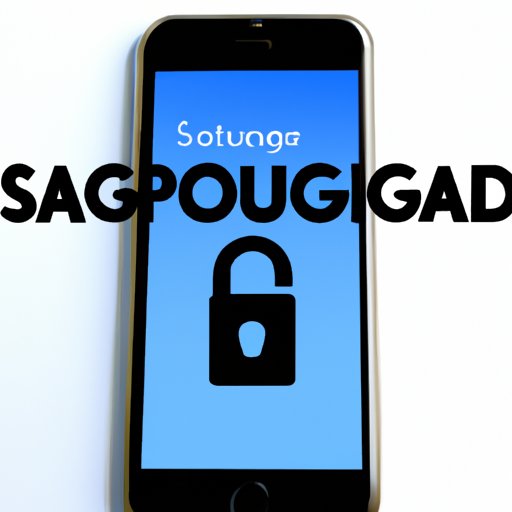Introduction
When it comes to data security, iPhone users rely on their passcodes as a first line of defense to keep their private information safe. If you’ve been using the same passcode for a while, or if you’re worried that someone else may have discovered it, it’s time to change it. Not sure how? In this article, we’ll provide a comprehensive guide on how to change your iPhone passcode, along with expert tips on how to safeguard your device and your privacy.
Step-by-Step Guide: Changing Your iPhone Passcode in 5 Minutes or Less
The process of changing your iPhone passcode is simple and straightforward. Follow these steps:
- Open the “Settings” app on your iPhone
- Tap “Touch ID & Passcode” (or “Face ID & Passcode”)
- Enter your current passcode
- Scroll down and tap “Change Passcode”
- Enter your current passcode again
- Enter your new passcode (make sure it’s at least six digits long or consider a phrase using letters and numbers)
- Re-enter your new passcode to confirm
That’s it! Your passcode has been updated, and your device is now more secure.

Safeguarding Your iPhone: Simple Steps to Changing Your Passcode
If you use your iPhone frequently, you know how important it is to protect your device and the data it contains. Here are some practical tips for creating a strong and memorable passcode:
- Avoid using simple, easy-to-guess codes, such as “1234.”
- Consider using a phrase instead of an actual word or number pattern. For example, “ilike2eatpizza!” is much harder to guess than “AbCdE1”.
- Avoid using personal information that someone could quickly find out, such as your birthday or phone number.
- Change your passcode regularly to prevent others from figuring it out.
- Make sure to avoid using Touch ID or Face ID instead of a passcode only. Your iPhone may get stolen and a PIN safeguards you against theft.
Protecting Your Privacy: Why Changing Your iPhone Passcode is Essential
Not changing your iPhone passcode regularly can lead to loss of privacy, exposing you to potential harm such as identity theft, unauthorized access to your personal and financial data, among others. Here are some reasons why iPhone passcode changes are essential:
- If someone else gains access to your iPhone, they can easily access your apps, personal information, and data.
- Without an updated passcode, your iPhone would be more vulnerable to malware, phishing attacks, and other security risks.
- If you’re worried about theft, having a passcode will prevent the thief from using your iPhone or accessing your personal information.
By changing your iPhone passcode regularly, you can reduce the risk of these and other security threats.
iPhone Passcode Changes Made Easy: Expert Tips and Tricks
If you want to change your iPhone passcode even easier, here are some tips and tricks:
- Use Touch ID or Face ID to access the “Touch ID & Passcode” (or “Face ID & Passcode”) settings quickly.
- Consider using a password manager to generate and store complex passwords for your iPhone passcode and other accounts.
- Do not share your password with anyone.
- Be mindful of what you access using public Wi-Fi networks. Use a virtual private network (VPN) or connect to a trusted wireless network to stay safe.
By following these simple tips and tricks, you can make the process of changing your iPhone passcode even easier and faster.
The Ultimate Guide to iPhone Passcode Changes: Best Practices and FAQs
To maximize the effectiveness of your iPhone passcode and ensure maximum protection, here are some best practices to keep in mind:
- Keep your iPhone updated to the latest version to guard against security vulnerabilities.
- Make sure to use a strong and complex passcode that is independently generated.
- Change your passcode regularly to improve its effectiveness.
- Consider using a two-factor authentication process.
- Never share your passcode with anyone.
Now, let’s answer some frequently asked questions about iPhone passcode changes.
- Q: What should I do if I forget my passcode? A: Use iTunes to restore your iPhone. WARNING! This will erase all content on your iPhone.
- Q: Can I change my passcode using Face ID? A: Yes, go to your “Face ID & Passcode” settings and follow the same steps.
- Q: Can I change my passcode using Siri? A: No, this could impair your iPhone’s security.
- Q: Do I need to enter my passcode to use Touch ID or Face ID? A: Yes, this ensures maximum security and privacy.
Mastering iPhone Security: Changing Your Passcode for Maximum Protection
Now that you know how to change your iPhone passcode, it’s time to take a closer look at how passcodes work to secure iPhones. iPhone passcodes use complex algorithms and encryption techniques to prevent unauthorized access to your device. By using a strong and memorable passcode, you can maximize your iPhone’s security and protect it from potential threats.
iOS Passcode Changes: Everything You Need to Know to Keep Your Phone Safe
To prevent issues related to passcode changes, ensure that you update your iOS version and follow all the best practices outlined in this article. By keeping your iPhone up to date, using a strong password, and changing your passcode regularly, you can protect your device from potential threats and keep your data safe.
Conclusion
Changing your iPhone passcode frequently will reduce the risk of security vulnerabilities and protect your personal information from unauthorized access. With this comprehensive guide, we hope we’ve made the process easy for you to understand and implement. Follow our best practices, expert tips, and tricks, and you’ll have peace of mind, knowing that your device is secured against potential threats and privacy invasions.
